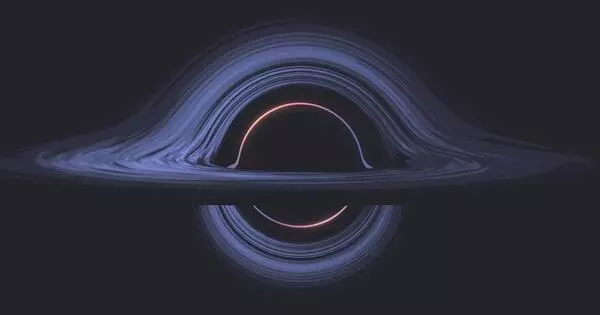The Event Horizon Telescope (EHT) collaboration published the first-ever direct image of a black hole in the center of the galaxy M87 in 2019. While the image did not directly show the black hole emitting a jet, it did show the presence of a bright ring-like structure surrounding the black hole, which is thought to be caused by hot gas and dust falling into the black hole and emitting radiation as it spirals inward.
Astronomers captured the shadow of the black hole at the center of the galaxy Messier 87 (M87) and the powerful jet expelled from it in one image. Astronomers can now better understand how black holes can produce such powerful jets thanks to this new image.
Astronomers have observed the shadow of the black hole at the center of the galaxy Messier 87 (M87) and the powerful jet expelled from it in the same image for the first time. The observations were carried out in 2018 using telescopes from the Global Millimeter VLBI Array (GMVA), the Atacama Large Millimeter/submillimeter Array (ALMA), with which ESO is a partner, and the Greenland Telescope (GLT). Thanks to this new image, astronomers can better understand how black holes can launch such energetic jets.
At the heart of most galaxies is a supermassive black hole. While black holes are well known for engulfing matter in their immediate vicinity, they can also launch powerful matter jets that extend beyond the galaxies in which they reside. Understanding how black holes generate such massive jets has long been a source of consternation in astronomy. “We know that jets are ejected from the region surrounding black holes,” says Ru-Sen Lu of China’s Shanghai Astronomical Observatory, “but we still do not fully understand how this occurs.” To study this directly, we need to observe the jet’s origin as close to the black hole as possible.”
At this wavelength, we can see how the jet emerges from the ring of emission around the central supermassive black hole. To understand the physical origin of the bigger and thicker ring, we had to use computer simulations to test different scenarios.
Thomas Krichbaum
For the first time, a new image published today shows how the base of a jet connects with the matter swirling around a supermassive black hole. The galaxy M87, 55 million light-years away in our cosmic neighborhood, is the target, and it contains a black hole 6.5 billion times more massive than the Sun.
Previous observations had imaged the region near the black hole and the jet separately, but this is the first time both features have been observed together. “This new image completes the picture by showing the region around the black hole as well as the jet at the same time,” says Jae-Young Kim of South Korea’s Kyungpook National University and Germany’s Max-Planck Institute for Radio Astronomy.
The image was obtained with the GMVA, ALMA and the GLT, forming a network of radio-telescopes around the globe working together as a virtual Earth-sized telescope. Such a large network can discern very small details in the region around M87’s black hole.

The new image depicts the jet emerging near the black hole, as well as what scientists refer to as the black hole’s shadow. Matter heats up and emits light as it orbits the black hole. As seen from Earth, the black hole bends and captures some of this light, forming a ring-like structure around it.
The black hole shadow in the center of the ring was first imaged by the Event Horizon Telescope (EHT) in 2017. Both this new image and the EHT image combine data from various radio telescopes around the world, but the image released today shows radio light emitted at a longer wavelength than the EHT image: 3.5 mm rather than 1.3 mm. “At this wavelength, we can see how the jet emerges from the ring of emission around the central supermassive black hole,” says Thomas Krichbaum of the Max Planck Institute for Radio Astronomy.
The size of the ring observed by the GMVA network is roughly 50% larger in comparison to the Event Horizon Telescope image. “To understand the physical origin of the bigger and thicker ring, we had to use computer simulations to test different scenarios,” explains Keiichi Asada from the Academia Sinica in Taiwan. The results suggest the new image reveals more of the material that is falling towards the black hole than what could be observed with the EHT.
These new observations of M87’s black hole were made in 2018 using the GMVA, a network of 14 radio telescopes located in Europe and North America. In addition, the Greenland Telescope and ALMA, in which ESO is a partner, were linked to the GMVA. ALMA, which consists of 66 antennas in Chile’s Atacama desert, was instrumental in these observations. The data collected by all of these telescopes around the world is combined using a technique known as interferometry, which synchronizes the signals collected by each facility. However, in order to properly capture the actual shape of an astronomical object, telescopes must be spread across the globe.
Because the GMVA telescopes are mostly aligned East-West, the addition of ALMA in the Southern hemisphere was critical in capturing this image of the jet and shadow of M87’s black hole. “Because of ALMA’s location and sensitivity, we were able to reveal the black hole shadow while also seeing deeper into the jet emission,” explains Lu.
Future observations with this network of telescopes will continue to shed light on how supermassive black holes can generate powerful jets. “We intend to observe the region around the black hole at the center of M87 at various radio wavelengths to further study the jet emission,” says Eduardo Ros of the Max Planck Institute for Radio Astronomy. Such simultaneous observations would enable the team to decipher the complex processes that occur near the supermassive black hole. “The coming years will be exciting, as we will be able to learn more about what happens near one of the most mysterious regions of the Universe,” Ros concludes.
















